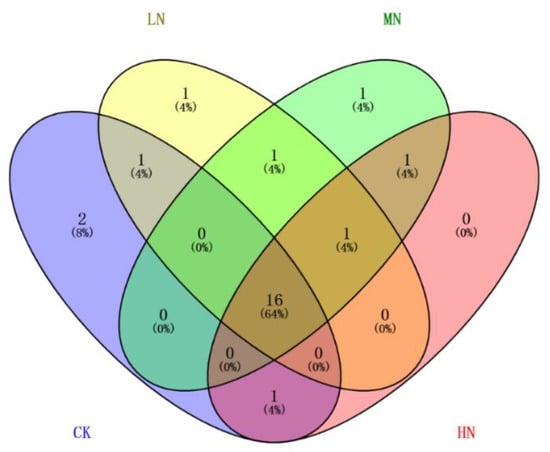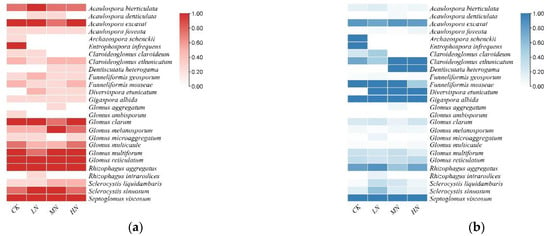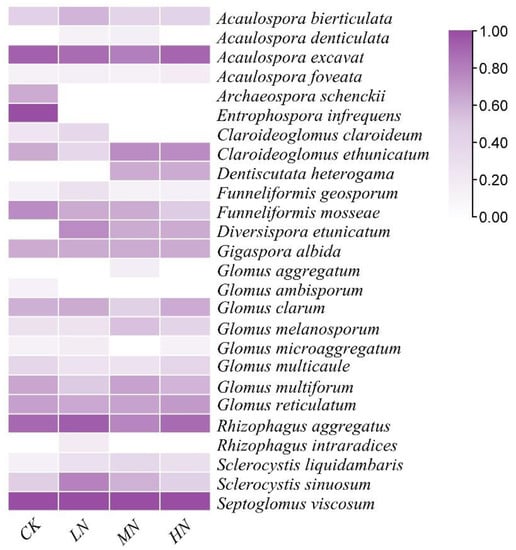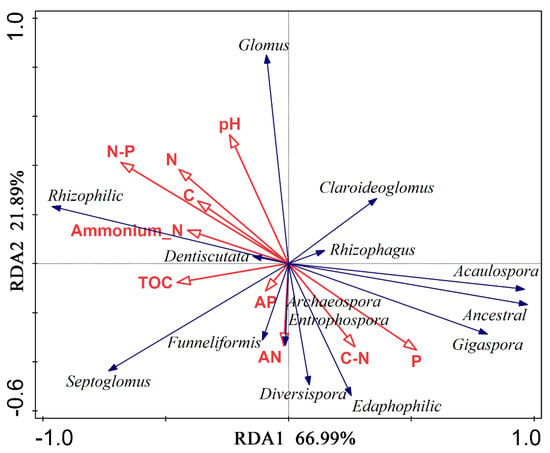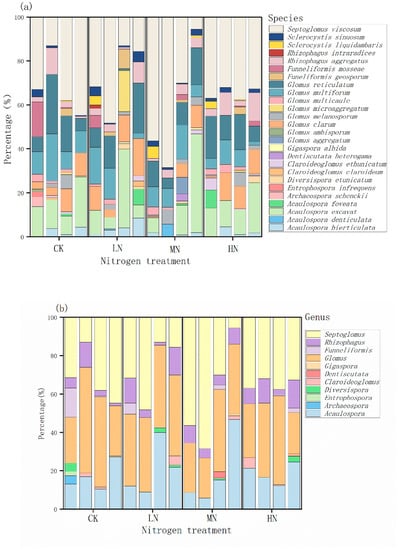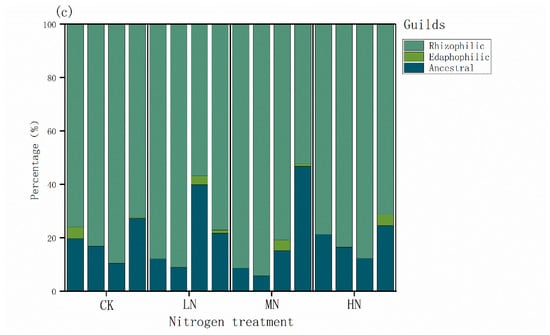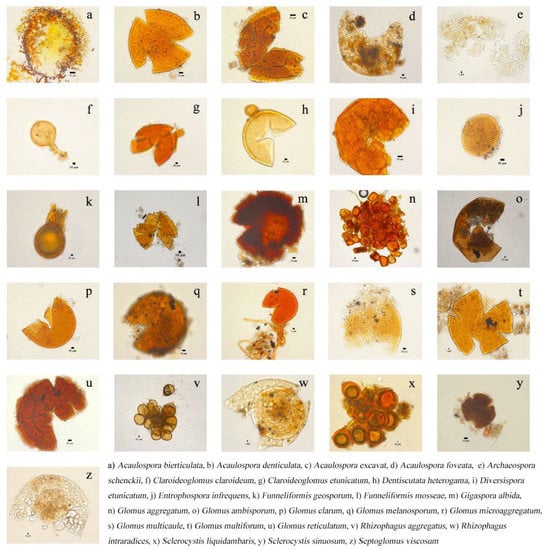Abstract
Aims: Our aim was to investigate how N addition affects arbuscular mycorrhizal fungal (AMF) growth in Chinese fir plantations. Methods: A Chinese fir plantation was treated with four different N addition treatments for one and half years starting in April 2019. AMF colonization, hyphal length density, community composition, and soil properties were under measurement. Results: N addition caused inapparent effects on AMF colonization, hyphal length density, and functional guilds (rhizophilic, edaphophilic, and ancestral). The predominant AMF species in the soil was Septoglomus viscosum. N addition altered AMF community and some rare species (e.g., Entrophospora infrequens) disappeared with N addition. Conclusion: AMF community structure was more sensitive to short-time N deposition than the symbiotic relationship between AMF and host plants.
1. Introduction
Atmospheric N deposition has increased strongly over the last decades due to N use in agriculture, fossil fuels, and land conservation [1,2], and ammonium nitrogen (NH4+-N), nitrate nitrogen (NO3−-N), and dissolved organic nitrogen deposition fluxes were up to 8.73, 8.73, and 9.98 kg N ha−1 yr−1, respectively [3]. Increased N deposition raises carbon sinks, increases N availability and NPP in some ecosystems [4], and typically acidifies soil [5]. Meanwhile, N deposition, due to its increasing rate and duration, possibly has a negative impact with on the growth, composition, and function of soil microbes. [6].
Arbuscular mycorrhizal fungi (AMF) are ubiquitous components belonging to the phylum Glomeromycota. They can form mycorrhizal symbionts with approximately 80% of land plants [7]. AMF gain a significant presence in increasing the uptake of N and P to their host plants [8,9] and improving disease resistance, which determines the stability and versatility of ecosystem [10]. It should be noted that AMF have intra- and extra-radical structures [11]. Based on their patterns at the family level, AMF can be classified as edaphophilic, rhizophilic, or ancestral. Rhizophilic AMF help plants reduce root pathogen infection with fine root, and edaphophilic AMF promote plant nutrients with extraradical mycelium [12].
AMF structure and community composition can be influenced by climate change, but the factors that affact AMF parameters are not well understood. Decreasing pH and P availability caused by N addition can make a big difference in changing soil properties [13,14], so plants need AMF to overcome resource limitations. However, the impact of N application on AMF remains controversial. AMF colonization might be decreased [15,16], promoted [17], or have no significant effect [18] by N addition. N addition can also enhance [18,19], suppress [20], or have no significant effect [21] on AMF spore density and hyphae. Some investigations showed that N addition treatments caused significant suppressive impacts on AMF abundance, richness, and diversity [22,23], whereas others found no significant impact [19,24]. Meanwhile, how these environmental factors shape the AMF community under N addition is not fully understood. A study observed that the relative abundance of AMF decreased the reduction of plant demand for N [25]. Importantly, the morphological modification of AMF caused by soil nutrient changes may be relevant to their composition owing to the differences of morphological internal responses to nutrient manipulations [26,27].
Chinese fir (Cunninghamia lanceolata) is a quick-growing timber tree species in south China [28]. On account of its high wood quality and termite resistance, it is frequently planted [29]. However, the productivity of the Chinese fir is declining due to soil acidification, soil aluminum poisoning, and unreasonable planting methods. Lu [30] showed that the number of AMF operational taxonomic units (OTUs) had an inverted V-shaped change with the age of the Chinese fir. Liu [14] found that the Chinese fir under N addition for 2 years would increase AMF colonization and diversity. Cao [31] observed that high N addition exerted a significant negative effect on AMF community. However, few studies showed the interactions of Chinese fir and AMF in terms of N deposition and nutrient availability. Therefore, we purposed to address these questions: (1) how does N addition affect AMF colonization and the diversity and composition of AMF in Chinese fir; (2) would the change of soil nutrients availability affect the responses of AMF groups?
2. Materials and Methods
2.1. Study Sites and Sampling
The soil experiment was carried out in the Fengyang Mountain Nature Reserve (28°53′56″ N, 190°10′56″ E), Zhejiang Province, China. The mean annual precipitation and annual temperature are 2400 mm and 12.3 °C. Soil properties (0–10 cm) are: total nitrogen (TN), 4.11 g kg−1; total carbon (TC), 58.73 g kg−1; NH4+-N, 15.71 mg g−1; NO3−-N, 14.66 mg g−1; total phosphorus (TP), 0.3 g kg−1; and bulk density, 0.76 g cm−3. The Chinese fir was 39 years old with an average diameter at breast height of 21.75 cm and 13.2 m height.
The local N deposition was estimated to be 34 kg N ha−1 yr−1. The N addition treatments included four different levels (four plots per treatment were considered as four independent repetitions, sixteen 10 m × 10 m plots in total) to simulate future climate change scenarios: no fertilization, 50 kg N ha−1 yr−1, 100 kg N ha−1 yr−1, and 200 kg N ha−1 yr−1, which were regarded as control (CK), low-nitrogen (LN), medium-nitrogen (MN), and high-nitrogen (HN), respectively. Separated adjacent plots were separated by a 10-m-wide buffer strip. From April 2019, N was added monthly by spraying urea (CO (NH2)2) solution on the forest floor as N addition treatments. Meanwhile, CK plots were sprayed with the same volume of water.
Samples were collected in November 2020. Along the “S” route, six standard trees were selected in each plot. Weeds and litter around the sample trees were removed before collecting. Roots and rhizosphere soil around the average standard tree were collected in the 0–20 cm soil layer from four directions. The fine roots and about 1000 g of rhizosphere soil (soils adhering to roots by shaking off root surface) from six standard trees were collected and mixed as one root and one soil sample in each plot, and sixteen root and soil samples were collected. The soil samples were used for soil physicochemical analysis and the measurement of AMF colonization, spore isolation studies, and measured hyphal length density (HLD). The soil samples were air-dried, and the properties were measured, while the other soil samples were stored with root samples (washed using tap water) in the refrigerator at 4 °C until used.
2.2. Soil Properties Analysis
All the soil samples were sieved through a 2 mm sieve. Soil pH was measured in a soil-to-water ratio of 1:2.5 (v/v). Soil NH4+-N and NO3−-N concentration were estimated by colorimetric analysis [32]. Soil available nitrogen (AN) is soil NH4+-N plus NO3−-N. Soil available phosphorus (AP) and total phosphorus (TP) were extracted by sodium bicarbonate first, and their contents were followed by molybdenum blue colorimetry [33]. Soil total organic carbon was measured by TOC-L CPH/CPN [34]. Soil total carbon (C) and total nitrogen (N) were measured by an elemental analyzer (Vario MACRO cube, Elementar Trading Shanghai, Shanghai, China).
2.3. AMF Colonization and Extraradical Hphae Length Density
To highlight AMF structures, roots samples were strained following the methods described by Philips and Hayman [35], and the percentage of mycorrhizal colonization was estimated in the light of McGonigle et al. [36]. Extraradical HLD was determined on the basis of the description by Jakoben et al. [37].
2.4. AMF Spore Separation and Identification
The AMF spores used for identification were obtained from the 20 g air-dried rhizosphere soil samples following the wet sieving and decanting techniques as described by Brundrett [38]. In order to determine the spore density, the isolated intact healthy spores were extracted and placed on filter paper. We separated them by color, spore size, ornamentations, hyphal attachments, and wall layers, and then used a dissecting microscope at 45× magnification to observe them. Spores were mounted on slides in polyvinyl–lactic acid–glycerine (PVLG) and a mixture of PVLG with Melzer’s (1:1; v/v). The spores were identified according to the International Culture Collection of Vesicular Arbuscular Mycorrhizal fungi (INVAM) (http://invam.caf.wvu.edu, last accessed in 21 May 2022) and recent advances in Glomeromycota taxonomy [39,40].
2.5. AMF Community Parameters and Statistical Analysis
The spore density (SD), frequency of occurrence (FO), relative abundance (RA), importance value (IA), Shannon–Wiener index (H), Simpson index (D), species richness (SR), and percentage were used to estimate the AMF community structure [41,42,43].
Correlation analysis was performed using SPSS 26.0 to test for relationship between the AMF community composition, parameters and soil properties. Venn was pictured for Venny 2.0. Graphical presentation was carried out using Origin 2022. Redundancy analysis (RDA) was conducted with Canoco 5.0 to reveal the influence of soil properties on the AMF communities.
3. Results
3.1. Effects of N Addition on Soil AMF Colonization, Spore Density, and External Hyphal Length Density
AMF colonization (p = 0.824), spore density (p = 0.229), and external hyphal length density (p = 0.435) were not significantly influenced by the nitrogen treatment (Table 1). The AMF colonization ranged from 74% to 88%. Spore density was highest in MN treatment, which averaged up to 365 spores per 1g air-dried soil, and spore density was lowest value in the control treatment. External HLD was highest in the control treatment, which averaged up to 5.10 m g−1, and was the lowest in the LN treatment.
3.2. Effects of N Addition on Soil AMF Community Composition
Although there was no significant effect of nitrogen treatment on the Shannon index and Simpson index, nitrogen addition decreased total spore richness (Table 1). The number of unique AMF species decreased gradually with N addition (Figure 1).
Figure 1.
Venn diagram showing the unique and shared arbuscular mycorrhizal fungi species under different nitrogen treatments. CK: no fertilization; LN: 50 kg N ha−1 yr−1; MN: 100 kg N ha−1 yr−1; HN: 200 kg N ha−1 yr−1.
In total, 26 AMF species of spore were detected in four nitrogen treatments (Figure 2; Table 2; Figure A1). These AMF belonged to 12 genera (Acaulospora, Archaeospora, Claroideoglomus, Dentiscutata, Diversispora, Entrophospora, Funneliformis, Gigaspora, Glomus, Rhizophagus, Sclerocystis, and Septoglomus) within six families (Acaulosporaceae, Ambisporaceae, Claroideoglomus, Diversisporaceae, Gigasporaceae, and Glomeraceae).
Figure 2.
The frequency of occurrences (a) and relative abundance (b) among arbuscular mycorrhizal fungi under different nitrogen treatments. CK: no fertilization; LN: 50 kg N ha−1 yr−1; MN: 100 kg N ha−1 yr−1; HN: 200 kg N ha−1 yr−1.
Table 2.
Occurrence frequency, relative abundance, and important values of arbuscular mycorrhizal fungi species in Chinese fir under nitrogen treatment.
Acaulospora bireticulata, Acaulospora excacat, Glomus clarum, Glomus melanosporum, Glomus multicaule, Glomus reticulatum, Rhizophagus aggregatus, Sclerocystis liquidambaris, and Septoglomus viscosum were the dominant species.
Among all treatments, we observed that IV top five were: Septoglomus viscosum (100%) > Rhizophagus aggregatus (98.70%) > Acaulospora excavat (87.69%) > Sclerocystis sinuosum (73.26%) > Glomus reticulatum (67.31%) (Table 2).
For the CK treatment, Septoglomus viscosum and Entrophospora infrequens (100%) had the highest IV, followed by Acaulospora excavat (92.13%), Rhizophagus aggregatus (89.29%), and Funneliformis mosseae (75.00%). For the LN treatment, Septoglomus viscosum (100%) presented the highest IV, followed by Rhizophagus aggregatus (93.75%), Acaulospora excavat (87.62%), Sclerocystis sinuosum (79.17%), and Diversispora etunicatum (75.00%). For the MN treatment, Septoglomus viscosum was the highest IV, followed by Acaulospora excavat (80.56%), Rhizophagus aggregatus (77.38%), Claroideoglomus etunicatum (75.00%), and Glomus multiform (66.35%). For the HN treatment, Septoglomus viscosum had the highest IV, followed by Acaulospora excavat (90.42%), Rhizophagus aggregatus (88.33%), Claroideoglomus etunicatum (75.00%), and Glomus reticultaum (69.56%) (Figure 3).
3.3. Effects of N addition on Soil Nutrients
For the environmental factors measured, added N had insignificant influence on soil pH. However, N addition increased soil N under LN treatment (+15.05%). Under LN treatment, soil AP and TP were the highest. Soil N/P increased slightly with N addition (Table 3).
3.4. Relationship between Soil Properties and AMF
AMF colonization was negatively correlated with soil TOC (p < 0.05) (Table 4), external HLD was negatively connected with soil P (p < 0.05), spore density was positively related to soil C (p < 0.05), and species richness was in a positive correlation with soil TOC and C (p < 0.05). The Shannon indices presented a positive correlation with soil pH (p < 0.05).
Table 4.
Spearman correlation coefficients between soil properties and parameters of arbuscular mycorrhizal fungi.
Archaeospora was in a negative correlation with soil N/P (p < 0.05), Funneliformis was positively correlated with soil TOC (p < 0.01), and Gigaspora was negatively connected with soil pH, NH4+-N (p < 0.05), and soil N/P (p < 0.01), but positively related to soil P and C/N (p < 0.05). Ancestral AMF was in a negative correlation with soil N/P (p < 0.01), edaphophilic AMF was negatively correlated with soil N/P (p < 0.05), and rhizophilic AMF was positively connected with soil N/P (p < 0.01) but negatively related to soil P (p < 0.05).
RDA was conducted to evaluate the relationship between the soil chemical properties and the AMF community (Figure 4). RDA1 accounted for 66.99% of the variations, while RDA2 accounted for 21.89%. Of the evaluated attributes, the N/P had significant conditional effects (p < 0.01), while the soil TOC (p = 0.076) and AN (p = 0.092) caused referential effects to the AMF communities.
Figure 4.
Redundancy analysis (RDA) at the genus level between the soil properties and arbuscular mycorrhizal fungi communities under different nitrogen treatments. TOC, total organic carbon; NH4+-N, ammonium nitrogen; AN, available nitrogen; AP, available phosphorus; C, total carbon; N, total nitrogen; P, total phosphorus. The red arrows represent soil properties, the blue arrows represent arbuscular mycorrhizal fungi communities.
4. Discussion
N addition can make a difference on AMF diversity and community composition, because with the increase of soil nutrients plants would have a strategy to acquire nutrients by fine roots or AMF [26,44]. Our results showed that N/P is a factor that has a significant effect on AMF communities (Figure 4). AMF community structure might have a connection with the dynamics of soil conditions and C-to-P trade between AMF and plants. It has been agreed that AMF exchanges P derived from soil for plant carbon [17,44,45,46,47]. In our study, N addition had insignificant influence on AMF colonization, external HLD, spore density, or diversity. This finding may be explained as the symbiotic relationship between AMF and root system being stable [48].
Generally, there is little specificity between AMF and the host plant, and several AMF species could colonize one AM plant at the same time [49,50]. However, different patterns of colonization with N addition suggest a preference for specific AMF species [51]. In our study, we observed that Glomeraceae was the most predominant family among all treatments; Glomus, Septoglomus, and Acaulospora were the predominant genera; and Septoglomus viscosum and Acaulospora foveata were the predominant species. Our results slightly disagree with previous studies, which presented that Glomus and Acaulospora as the predominant species due to their smaller size of spore, which helped them produce more spores in less time [48,52,53]. This discrepancy can be answered by the diverse species and age of the host plants. The high isolation frequencies of Septoglomus viscosum indicated that it has a strong ability to adapt to the environment (N deposition). Septoglomus viscosum can improve plant growth and production [54], which is mainly related to root and aboveground biomass [55].
Archaeospora schenckii, Entrophospora infrequens, and Glomus ambisporum disappeared with N treatments (Figure 3), which was in keeping with Eom [19], who also found that Entrophospora infrequens decreased with N addition. In P-rich (low N/P) soils, nitrogen application reduces underground carbon allocation, and rare species decrease as N increases. A previous study showed that the influence of N addition on AMF community appeared different, with added N promoting Glomeraceae in A. Sieversiana, while lessening them in L. chinensis [16]. Some Glomus species were sensitive to N application, which indicated that certain species of AMF play an indispensable role in host plant response to environmental change.
As identified in most surveys conducted in other fields [56,57,58], we also discovered Funneliformis mosseae presenting in our study, which was reported to promote plant nutrients [59]. GmosAAP1, an amino acid permease, has been characterized from the extraradical structure of Funneliformis mosseae, which indicates a potential for amino acid uptake [60]. Our study showed that with N addition, its importance decreased. This decrease may be explained by a decrease in the dependency on Funneliformis mosseae for N nutrient acquisition by the host plant.
Above all, our results showed that AMF, participating in and manage the soil nutrient cycle, could be sensitive to small changes in edatopes. Therefore, studying mycorrhizal symbionts increases the knowledge of climatic variation [61,62,63].
AMF were grouped into three guilds, namely, edaphophilic, rhizophilc, and ancestral. In our study, the percentage followed the order: rhizophilic > edaphophilic > ancestral (Figure 5c). N addition altered AMF species but did not change functional groups. Despite the addition of nitrogen, trees may reduce dependence on AMF. Meanwhile, a large group of rhizophilic guilds function to reduce root pathogen infection and primarily benefit plants with fine roots prone to pathogen infections.
Figure 5.
Arbuscular mycorrhizal fungi community composition at the genus (a), species (b), and classified guilds (c) under different nitrogen (N) treatments. CK: no fertilization; LN: 50 kg N ha−1 yr−1; MN: 100 kg N ha−1 yr−1; HN: 200 kg N ha−1 yr−1.
Many essential factors can influence the life cycle of AMF, such as the species of host plants [16], light availability [64], temperature [65], rainfall [66], elevation [61], soil properties [67,68,69], and the plant community [70]. However, there is no major factor affecting AMF. In our study, AMF colonization and SR were in significant correlation with soil TOC, and AMF SD and SR were significantly correlated with soil C. AMF community structure showed a significant positive correlation with soil C, in keeping with some AMF that were motivated as the content of organic matter increased [56,71,72].
Individual abundances of AMF spores also presented interannual differences. AMF communities, well-known for efficient interannual variability of spores, and our results suggested a small number of AMF responded to N fertilization. The randomness of this species response implies that a short-time study on AMF may not be sufficient to catch variations in the response to N addition [48,73].
Even the spore community could not reflect the active colonizing AMF community composition [74], but it remains a useful indicator for when we need a reference of ecological change in replicated treatments. We can observe changes which we can measure to try to predict unmeasurable sources that are also changing, perhaps they may even predict more than the spores of AMF subsets.
5. Conclusions
We found that added N caused no significant impact to AMF colonization, hyphal length density, and classified guilds (rhizophilic, edaphophilic, and ancestral). Septoglomus viscosum was the predominant species in all different N addition treatments. N addition altered AMF community, and some rare species (eg. Entrophospora infrequens) disappeared. Our findings supported that compared with AMF structure, AMF community composition is more sensitive to short-time N deposition, and more attention should be paid to AMF community structure in future studies.
Author Contributions
Conceptualization, F.W. and X.Z.; methodology, J.J. and F.W.; software, X.G. and F.W.; validation, X.Z. and J.J.; formal analysis, J.J. and F.W.; investigation, J.J.; resources, F.W., X.Z. and M.C.; data curation, F.W.; writing—original draft preparation, F.W.; writing—review and editing, J.J. and X.Z.; visualization, F.W.; supervision, M.C. and X.G.; project administration, J.J.; funding acquisition, J.J. All authors have read and agreed to the published version of the manuscript.
Funding
This research was funded by the National Natural Science Foundation of China, grant number 32071612, and the Postgraduate Research & Practice Innovation Program of Jiangsu Province.
Institutional Review Board Statement
Not applicable.
Informed Consent Statement
Not applicable.
Data Availability Statement
The data that support the findings of this study are available from the authors upon reasonable request.
Acknowledgments
We thank Hong-ting Guo and Shan-feng Du at the Collaborative Innovation Center of Sustainable Forestry in Southern China of Jiangsu Province, Nanjing Forestry University, Nanjing 210037, China, for their assistance in the field work.
Conflicts of Interest
The authors declare no conflict of interest.
References
- Ackerman, D.; Millet, D.B.; Chen, X. Global Estimates of Inorganic Nitrogen Deposition Across Four Decades. Glob. Biogeochem. Cycles 2018, 33, 100–107. [Google Scholar] [CrossRef] [Green Version]
- Liu, D.; Guo, X.; Xiao, B. What causes growth of global greenhouse gas emissions? Evidence from 40 countries. Sci. Total Environ. 2019, 661, 750–766. [Google Scholar] [CrossRef]
- Wen, Z.; Wang, R.; Li, Q.; Liu, J.; Ma, X.; Xu, W.; Tang, A.; Collett, J.L.; Li, H.; Liu, X. Spatiotemporal variations of nitrogen and phosphorus deposition across China. Sci. Total Environ. 2022, 830, 154740. [Google Scholar] [CrossRef]
- Thomas, R.Q.; Canham, C.; Weathers, K.C.; Goodale, C. Increased tree carbon storage in response to nitrogen deposition in the US. Nat. Geosci. 2009, 3, 229–244. [Google Scholar] [CrossRef]
- Stevens, C.J.; David, T.I.; Storkey, J. Atmospheric nitrogen deposition in terrestrial ecosystems: Its impact on plant communities and consequences across trophic levels. Funct. Ecol. 2018, 32, 1757–1769. [Google Scholar] [CrossRef] [Green Version]
- Zhang, T.; Chen, H.Y.H.; Ruan, H. Global negative effects of nitrogen deposition on soil microbes. ISME J. 2018, 12, 1817–1825. [Google Scholar] [CrossRef] [Green Version]
- Smith, S.E.; Smith, F.A. Roles of Arbuscular Mycorrhizas in Plant Nutrition and Growth: New Paradigms from Cellular to Ecosystem Scales. Annu. Rev. Plant Biol. 2010, 62, 227–250. [Google Scholar] [CrossRef] [Green Version]
- Etesami, H.; Jeong, B.R.; Glick, B.R. Contribution of Arbuscular Mycorrhizal Fungi, Phosphate–Solubilizing Bacteria, and Silicon to P Uptake by Plant. Front. Plant Sci. 2021, 12, 699618. [Google Scholar] [CrossRef]
- Liu, H.; Wu, Y.; Xu, H.; Ai, Z.; Zhang, J.; Liu, G.; Xue, S. N enrichment affects the arbuscular mycorrhizal fungi-mediated relationship between a C4 grass and a legume. Plant Physiol. 2021, 187, 1519–1533. [Google Scholar] [CrossRef]
- Ma, X.; Geng, Q.; Zhang, H.; Bian, C.; Chen, H.Y.H.; Jiang, D.; Xu, X. Global negative effects of nutrient enrichment on arbuscular mycorrhizal fungi, plant diversity and ecosystem multifunctionality. New Phytol. 2020, 229, 2957–2969. [Google Scholar] [CrossRef]
- Han, Y.; Feng, J.; Han, M.; Zhu, B. Responses of arbuscular mycorrhizal fungi to nitrogen addition: A meta-analysis. Glob. Chang. Biol. 2020, 26, 7229–7241. [Google Scholar] [CrossRef]
- Weber, S.E.; Diez, J.M.; Andrews, L.V.; Goulden, M.L.; Aronson, E.L.; Allen, M.F. Responses of arbuscular mycorrhizal fungi to multiple coinciding global change drivers. Fungal Ecol. 2019, 40, 62–71. [Google Scholar] [CrossRef]
- Xiao, D.; Che, R.; Liu, X.; Tan, Y.; Yang, R.; Zhang, W.; He, X.; Xu, Z.; Wang, K. Arbuscular mycorrhizal fungi abundance was sensitive to nitrogen addition but diversity was sensitive to phosphorus addition in karst ecosystems. Biol. Fertil. Soils 2019, 55, 457–469. [Google Scholar] [CrossRef]
- Liu, M.; Shen, Y.; Li, Q.; Xiao, W.; Song, X. Arbuscular mycorrhizal fungal colonization and soil pH induced by nitrogen and phosphorus additions affects leaf C:N:P stoichiometry in Chinese fir (Cunninghamia lanceolata) forests. Plant Soil 2021, 461, 421–440. [Google Scholar] [CrossRef]
- Van Diepen, L.T.A.; Lilleskov, E.A.; Pregitzer, K.S.; Miller, R.M. Decline of arbuscular mycorrhizal fungi in northern hardwood forests exposed to chronic nitrogen additions. New Phytol. 2007, 176, 175–183. [Google Scholar] [CrossRef]
- Pan, S.; Wang, Y.; Qiu, Y.; Chen, D.; Zhang, L.; Ye, C.; Guo, H.; Zhu, W.; Chen, A.; Xu, G.; et al. Nitrogen-induced acidification, not N-nutrient, dominates suppressive N effects on arbuscular mycorrhizal fungi. Glob. Chang. Biol. 2020, 26, 6568–6580. [Google Scholar] [CrossRef]
- Lekberg, Y.; Arnillas, C.A.; Borer, E.T.; Bullington, L.S.; Fierer, N.; Kennedy, P.G.; Leff, J.W.; Luis, A.D.; Seabloom, E.W.; Henning, J.A. Nitrogen and phosphorus fertilization consistently favor pathogenic over mutualistic fungi in grassland soils. Nat. Commun. 2021, 12, 3484. [Google Scholar] [CrossRef]
- Wang, X.; Sui, X.; Liu, Y.; Xiang, L.; Zhang, T.; Fu, J.; Li, A.; Yang, P. NP fertilization did not reduce AMF abundance or diversity but alter AMF composition in an alpine grassland infested by a root hemiparasitic plant. Plant Divers. 2018, 40, 117–126. [Google Scholar] [CrossRef]
- Eom, A.H.; Hartnett, D.C.; Wilson, G.W.; Figge, D.A. The Effect of Fire, Mowing and Fertilizer Amendment on Arbuscular Mycorrhizas in Tallgrass Prairie. Am. Midl. Nat. 1999, 142, 55–70. [Google Scholar] [CrossRef]
- Zhang, T.; Yang, X.; Guo, R.; Guo, J. Response of AM fungi spore population to elevated temperature and nitrogen addition and their influence on the plant community composition and productivity. Sci. Rep. 2016, 6, 24749. [Google Scholar] [CrossRef] [Green Version]
- Treseder, K.K.; Allen, M.F. Direct nitrogen and phosphorus limitation of arbuscular mycorrhizal fungi: A model and field test. New Phytol. 2002, 155, 507–515. [Google Scholar] [CrossRef] [Green Version]
- Camenzind, T.; Homeier, J.; Dietrich, K.; Hempel, S.; Hertel, D.; Krohn, A.; Leuschner, C.; Oelmann, Y.; Olsson, P.A.; Suárez, J.P.; et al. Opposing effects of nitrogen versus phosphorus additions on mycorrhizal fungal abundance along an elevational gradient in tropical montane forests. Soil Biol. Biochem. 2016, 94, 37–47. [Google Scholar] [CrossRef]
- Camenzind, T.; Hempel, S.; Homeier, J.; Horn, S.; Velescu, A.; Wilcke, W.; Rillig, M.C. Nitrogen and phosphorus additions impact arbuscular mycorrhizal abundance and molecular diversity in a tropical montane forest. Glob. Chang. Biol. 2014, 20, 3646–3659. [Google Scholar] [CrossRef] [Green Version]
- Mueller, R.C.; Bohannan, B.J.M. Shifts in the phylogenetic structure of arbuscular mycorrhizal fungi in response to experimental nitrogen and carbon dioxide additions. Oecologia 2015, 179, 175–185. [Google Scholar] [CrossRef]
- Corkidi, L.; Rowland, D.L.; Johnson, N.C.; Allen, E.B. Nitrogen fertilization alters the functioning of arbuscular mycorrhizas at two semiarid grasslands. Plant Soil 2002, 240, 299–310. [Google Scholar] [CrossRef]
- Li, L.; McCormack, M.L.; Chen, F.; Wang, H.; Ma, Z.; Guo, D. Different responses of absorptive roots and arbuscular mycorrhizal fungi to fertilization provide diverse nutrient acquisition strategies in Chinese fir. For. Ecol. Manag. 2019, 433, 64–72. [Google Scholar] [CrossRef]
- Sheldrake, M.; Rosenstock, N.P.; Mangan, S.; Revillini, D.; Sayer, E.J.; Olsson, P.A.; Verbruggen, E.; Tanner, E.V.J.; Turner, B.L.; Wright, S.J. Responses of arbuscular mycorrhizal fungi to long-term inorganic and organic nutrient addition in a lowland tropical forest. ISME J. 2018, 12, 2433–2445. [Google Scholar] [CrossRef] [Green Version]
- Xiang, W.; Li, L.; Ouyang, S.; Xiao, W.; Zeng, L.; Chen, L.; Lei, P.; Deng, X.; Zeng, Y.; Fang, J.; et al. Effects of stand age on tree biomass partitioning and allometric equations in Chinese fir (Cunninghamia lanceolata) plantations. Forstwiss. Centralblatt 2021, 140, 317–332. [Google Scholar] [CrossRef]
- Wu, H.; Xiang, W.; Ouyang, S.; Xiao, W.; Li, S.; Chen, L.; Lei, P.; Deng, X.; Zeng, Y.; Zeng, L.; et al. Tree growth rate and soil nutrient status determine the shift in nutrient-use strategy of Chinese fir plantations along a chronosequence. For. Ecol. Manag. 2020, 460, 117896. [Google Scholar] [CrossRef]
- Lu, N.; Xu, X.; Wang, P.; Zhang, P.; Ji, B.; Wang, X. Succession in arbuscular mycorrhizal fungi can be attributed to a chronosequence of Cunninghamia lanceolata. Sci. Rep. 2019, 9, 18057. [Google Scholar] [CrossRef] [Green Version]
- Cao, J.; Lin, T.-C.; Yang, Z.; Zheng, Y.; Xie, L.; Xiong, D.; Yang, Y. Warming exerts a stronger effect than nitrogen addition on the soil arbuscular mycorrhizal fungal community in a young subtropical Cunninghamia lanceolata plantation. Geoderma 2020, 367, 114273. [Google Scholar] [CrossRef]
- Deng, B.-L.; Wang, S.-L.; Xu, X.-T.; Wang, H.; Hu, D.-N.; Guo, X.-M.; Shi, Q.-H.; Siemann, E.; Zhang, L. Effects of biochar and dicyandiamide combination on nitrous oxide emissions from Camellia oleifera field soil. Environ. Sci. Pollut. Res. 2019, 26, 4070–4077. [Google Scholar] [CrossRef]
- Zhou, X.; Sun, H.; Pumpanen, J.; Sietiö, O.-M.; Heinonsalo, J.; Köster, K.; Berninger, F. The impact of wildfire on microbial C:N:P stoichiometry and the fungal-to-bacterial ratio in permafrost soil. Biogeochemistry 2010, 142, 1–17. [Google Scholar] [CrossRef] [Green Version]
- Huang, J.; Lin, T.-C.; Xiong, D.; Yang, Z.; Liu, X.; Chen, G.; Xie, J.; Li, Y.; Yang, Y. Organic carbon mineralization in soils of a natural forest and a forest plantation of southeastern China. Geoderma 2019, 344, 119–126. [Google Scholar] [CrossRef]
- Phillips, J.M. Improved procedures for clearing roots and staining parasitic and vesicular-arbuscular mycorrhizal fungi for rapid assessment of infection. Trans. Br. Mycol. Soc. 1970, 55, 158–161. [Google Scholar] [CrossRef]
- Mcgonigle, T.P.; Miller, M.H.; Evans, D.G.; Fairchild, G.L.; Swan, J.A. A new method which gives an objective measure of colonization of roots by vesicular—Arbuscular mycorrhizal fungi. New Phytol. 1990, 115, 495–501. [Google Scholar] [CrossRef]
- Jakobsen, I.; Abbott, L.; Robson, A.D. External hyphae of vesicular-arbuscular mycorrhizal fungi associated with Trifolium subterraneum L. Spread of hyphae and phosphorus inflow into roots. New Phytol. 1992, 120, 371–380. [Google Scholar] [CrossRef]
- Brundrett, M.C. Mycorrhizas in Natural Ecosystems. Adv. Ecol. Res. 1991, 21, 171–313. [Google Scholar]
- Krüger, M.; Krüger, C.; Walker, C.; Stockinger, H.; Schüßler, A. Phylogenetic reference data for systematics and phylotaxonomy of arbuscular mycorrhizal fungi from phylum to species level. New Phytol. 2011, 193, 970–984. [Google Scholar] [CrossRef]
- Oehl, F.; Sieverding, E.; Palenzuela, J.; Ineichen, K.; Silva, G. Advances in Glomeromycota taxonomy and classification. IMA Fungus 2011, 2, 191–199. [Google Scholar] [CrossRef]
- Wang, J.; Wang, G.G.; Zhang, B.; Yuan, Z.; Fu, Z.; Yuan, Y.; Zhu, L.; Ma, S.; Zhang, J. Arbuscular Mycorrhizal Fungi Associated with Tree Species in a Planted Forest of Eastern China. Forests 2019, 10, 424. [Google Scholar] [CrossRef] [Green Version]
- Shannon, C.E.; Weaver, W. The Mathematical Theory of Communication; The University of Illinois Press: Urbana, IL, USA, 1949. [Google Scholar]
- Simpson, E.H. Measurement of Diversity. Nature 1949, 163, 688. [Google Scholar] [CrossRef]
- Ma, X.; Zhu, B.; Nie, Y.; Liu, Y.; Kuzyakov, Y. Root and mycorrhizal strategies for nutrient acquisition in forests under nitrogen deposition: A meta-analysis. Soil Biol. Biochem. 2021, 163, 108418. [Google Scholar] [CrossRef]
- Johnson, N.C. Resource stoichiometry elucidates the structure and function of arbuscular mycorrhizas across scales. New Phytol. 2010, 185, 631–647. [Google Scholar] [CrossRef]
- Avolio, M.L.; Koerner, S.; La Pierre, K.J.; Wilcox, K.; Wilson, G.W.T.; Smith, M.D.; Collins, S. Changes in plant community composition, not diversity, during a decade of nitrogen and phosphorus additions drive above-ground productivity in a tallgrass prairie. J. Ecol. 2015, 102, 1649–1660. [Google Scholar] [CrossRef] [Green Version]
- Isbell, F.; Reich, P.B.; Tilman, D.; Hobbie, S.E.; Polasky, S.; Binder, S. Nutrient enrichment, biodiversity loss, and consequent declines in ecosystem productivity. Proc. Natl. Acad. Sci. USA 2013, 110, 11911–11916. [Google Scholar] [CrossRef] [Green Version]
- Egerton-Warburton, L.M.; Johnson, N.C.; Allen, E.B. Mycorrhizal community dynamics following nitrogen fertilization: A cross-site test in five grasslands. Ecol. Monogr. 2007, 77, 527–544. [Google Scholar] [CrossRef] [Green Version]
- Jansa, J.; Mozafar, A.; Kuhn, G.; Anken, T.; Ruh, R.; Sanders, I.R.; Frossard, E.J.E.A. Soil tillage affects the community structure of mycorrhizal dungi in maize roots. Ecol. Appl. 2003, 13, 1164–1176. [Google Scholar] [CrossRef] [Green Version]
- Campos, P.D.S.; Borie, F.; Cornejo, P.; Lopez-Raez, J.A.; López-García, J.A.; Seguel, A. Phosphorus Acquisition Efficiency Related to Root Traits: Is Mycorrhizal Symbiosis a Key Factor to Wheat and Barley Cropping? Front. Plant Sci. 2018, 9, 752. [Google Scholar] [CrossRef]
- López-García, Á.; Varela-Cervero, S.; Vasar, M.; Öpik, M.; Barea, J.M.; Azcón-Aguilar, C. Plant traits determine the phylogenetic structure of arbuscular mycorrhizal fungal communities. Mol. Ecol. 2017, 26, 6948–6959. [Google Scholar] [CrossRef]
- Oehl, F.; Sieverding, E.; Ineichen, K.; Ris, E.; Boller, T.; Wiemken, A. Community structure of arbuscular mycorrhizal fungi at different soil depths in extensively and intensively managed agroecosystems. New Phytol. 2005, 165, 273–283. [Google Scholar] [CrossRef] [PubMed]
- Jamiołkowska, A.; Księżniak, A.; Gałązka, A.; Hetman, B.; Kopacki, M.; Skwaryło-Bednarz, B. Impact of abiotic factors on development of the community of arbuscular mycorrhizal fungi in the soil: A Review. Int. Agrophys. 2018, 32, 133–140. [Google Scholar] [CrossRef]
- Tedone, L.; Ruta, C.; De Cillis, F.; De Mastro, G. Effects of Septoglomus viscosum inoculation on biomass yield and steviol glycoside concentration of some Stevia rebaudiana chemotypes. Sci. Hortic. 2020, 262, 109026. [Google Scholar] [CrossRef]
- Todeschini, V.; AitLahmidi, N.; Mazzucco, E.; Marsano, F.; Gosetti, F.; Robotti, E.; Bona, E.; Massa, N.; Bonneau, L.; Marengo, E.; et al. Impact of Beneficial Microorganisms on Strawberry Growth, Fruit Production, Nutritional Quality, and Volatilome. Front. Plant Sci. 2018, 9, 1611. [Google Scholar] [CrossRef] [PubMed]
- Alguacil, M.D.M.; Torrecillas, E.; García-Orenes, F.; Roldan, A. Changes in the composition and diversity of AMF communities mediated by management practices in a Mediterranean soil are related with increases in soil biological activity. Soil Biol. Biochem. 2014, 76, 34–44. [Google Scholar] [CrossRef]
- Borriello, R.; Lumini, E.; Girlanda, M.; Bonfante, P.; Bianciotto, V. Effects of different management practices on arbuscular mycorrhizal fungal diversity in maize fields by a molecular approach. Biol. Fertil. Soils 2012, 48, 911–922. [Google Scholar] [CrossRef]
- Avio, L.; Castaldini, M.; Fabiani, A.; Bedini, S.; Sbrana, C.; Turrini, A.; Giovannetti, M. Impact of nitrogen fertilization and soil tillage on arbuscular mycorrhizal fungal communities in a Mediterranean agroecosystem. Soil Biol. Biochem. 2013, 67, 285–294. [Google Scholar] [CrossRef]
- Karasawa, T.; Hodge, A.; Fitter, A.H. Growth, respiration and nutrient acquisition by the arbuscular mycorrhizal fungus Glomus mosseae and its host plant Plantago lanceolata in cooled soil. Plant Cell Environ. 2012, 35, 819–828. [Google Scholar] [CrossRef]
- Cappellazzo, G.; Lanfranco, L.; Fitz, M.; Wipf, D.; Bonfante, P. Characterization of an Amino Acid Permease from the Endomycorrhizal Fungus Glomus mosseae. Plant Physiol. 2008, 147, 429–437. [Google Scholar] [CrossRef] [Green Version]
- Zhang, M.; Shi, Z.; Yang, M.; Lu, S.; Cao, L.; Wang, X. Molecular Diversity and Distribution of Arbuscular Mycorrhizal Fungi at Different Elevations in Mt. Taibai of Qinling Mountain. Front. Microbiol. 2021, 12, 609386. [Google Scholar] [CrossRef]
- Shi, G.; Yao, B.; Liu, Y.; Jiang, S.; Wang, W.; Pan, J.; Zhao, X.; Feng, H.; Zhou, H. The phylogenetic structure of AMF communities shifts in response to gradient warming with and without winter grazing on the Qinghai–Tibet Plateau. Appl. Soil Ecol. 2017, 121, 31–40. [Google Scholar] [CrossRef]
- Panneerselvam, P.; Kumar, U.; Senapati, A.; Parameswaran, C.; Anandan, A.; Kumar, A.; Jahan, A.; Padhy, S.R.; Nayak, A.K. Influence of elevated CO2 on arbuscular mycorrhizal fungal community elucidated using Illumina MiSeq platform in sub-humid tropical paddy soil. Appl. Soil Ecol. 2019, 145, 103344. [Google Scholar] [CrossRef]
- Neuenkamp, L.; Zobel, M.; Koorem, K.; Jairus, T.; Davison, J.; Öpik, M.; Vasar, M.; Moora, M. Light availability and light demand of plants shape the arbuscular mycorrhizal fungal communities in their roots. Ecol. Lett. 2021, 24, 426–437. [Google Scholar] [CrossRef] [PubMed]
- Bunn, R.; Lekberg, Y.; Zabinski, C. Arbuscular mycorrhizal fungi ameliorate temperature stress in thermophilic plants. Ecology 2009, 90, 1378–1388. [Google Scholar] [CrossRef] [PubMed]
- Wang, J.; Zhang, J.; Wang, C.; Ren, G.; Yang, Y.; Wang, D. Precipitation exerts a strong influence on arbuscular mycorrhizal fungi community and network complexity in a semiarid steppe ecosystem. Eur. J. Soil Biol. 2021, 102, 103268. [Google Scholar] [CrossRef]
- Chen, Y.-L.; Xu, Z.-W.; Xu, T.-L.; Veresoglou, S.D.; Yang, G.; Chen, B. Nitrogen deposition and precipitation induced phylogenetic clustering of arbuscular mycorrhizal fungal communities. Soil Biol. Biochem. 2017, 115, 233–242. [Google Scholar] [CrossRef]
- Li, X.; Qi, Z.; Yu, X.; Xu, M.; Liu, Z.; Du, G.; Yang, Y. Soil pH drives the phylogenetic clustering of the arbuscular mycorrhizal fungal community across subtropical and tropical pepper fields of China. Appl. Soil Ecol. 2021, 165, 103978. [Google Scholar] [CrossRef]
- Antunes, P.M.; Lehmann, A.; Hart, M.M.; Baumecker, M.; Rillig, M.C. Long-term effects of soil nutrient deficiency on arbuscular mycorrhizal communities. Funct. Ecol. 2012, 26, 532–540. [Google Scholar] [CrossRef]
- Zhang, J.; Quan, C.; Ma, L.; Chu, G.; Liu, Z.; Tang, X. Plant community and soil properties drive arbuscular mycorrhizal fungal diversity: A case study in tropical forests. Soil Ecol. Lett. 2021, 3, 52–62. [Google Scholar] [CrossRef]
- Gryndler, M.; Hršelová, H.; Sudová, R.; Gryndlerová, H.; Řezáčová, V.; Merhautová, V. Hyphal growth and mycorrhiza formation by the arbuscular mycorrhizal fungus Glomus claroideum BEG 23 is stimulated by humic substances. Mycorrhiza 2005, 15, 483–488. [Google Scholar] [CrossRef]
- Oehl, F.; Sieverding, E.; Ineichen, K.; Mäder, P.; Wiemken, A.; Boller, T. Distinct sporulation dynamics of arbuscular mycorrhizal fungal communities from different agroecosystems in long-term microcosms. Agric. Ecosyst. Environ. 2009, 134, 257–268. [Google Scholar] [CrossRef]
- Mosbah, M.; Philippe, D.L.; Mohamed, M. Molecular identification of arbuscular mycorrhizal fungal spores associated to the rhizosphere of Retama raetam in Tunisia. Soil Sci. Plant Nutr. 2018, 64, 335–341. [Google Scholar] [CrossRef]
- Wolf, J.; Johnson, N.C.; Rowland, D.L.; Reich, P.B. Elevated CO2 and plant species richness impact arbuscular mycorrhizal fungal spore communities. New Phytol. 2003, 157, 579–588. [Google Scholar] [CrossRef] [PubMed] [Green Version]
Publisher’s Note: MDPI stays neutral with regard to jurisdictional claims in published maps and institutional affiliations. |
© 2022 by the authors. Licensee MDPI, Basel, Switzerland. This article is an open access article distributed under the terms and conditions of the Creative Commons Attribution (CC BY) license (https://creativecommons.org/licenses/by/4.0/).

